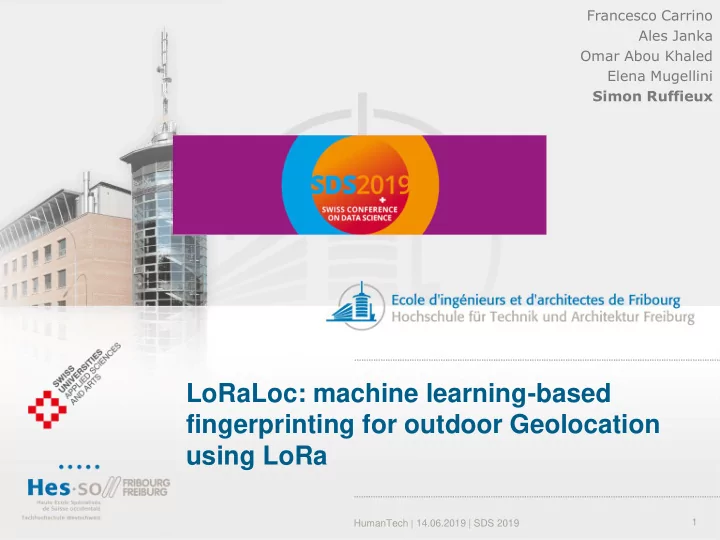

Francesco Carrino Ales Janka Omar Abou Khaled Elena Mugellini Simon Ruffieux LoRaLoc: machine learning-based fingerprinting for outdoor Geolocation using LoRa 1 HumanTech | 14.06.2019 | SDS 2019
Outline • Context and goals • Methodology • Results and discussion • Conclusion and perspectives 2
Context and goals 3
Context • IoT and Geolocation opportunities! • GPS LoRaWAN Architecture (source: https://www.thethingsnetwork.org/docs/lorawan/) – High power consumption – Only outdoor • LoRa – Lo ng Ra nge – Low power consumption – Can be used also indoor 4
Context – Geolocation using LoRa • LoRa for geolocation – Time of Arrival (TOA) Vs. Time Difference of Arrival/Flight ( TDOA /TDOF) – Line-of-sight Gateway (precisely synchronized time references) End-device (clock not synchronized) Gateway (precisely synchronized time references) Gateway (precisely synchronized time references) 5
Challenges - Non-line-of-sight • Challenge 1: In urban environments: Non-line-of-sight conditions Gateway X End-device Gateway Gateway • Challenge 2: Real data not (yet) available, costly to collect, small dataset… 6
Idea: fingerprinting & machine learning & simulator • GPS & LoRa reference map Latitude Longitude 7
Algorithm idea TDOA 0.5 Nan 0.2 Gateway 0.05 NaN NaN 0 0.1 … Model Corrected geolocation Input vector 8
Methodology 9
Simulator • No real data – > Simulator • Goals: – Testing algorithms – Transfer learning • Data generation – Ground Truth – GPS dataset – LoRa dataset • Sensors’ systematic error + “Local” noise (i.e., geolocated circular masks) • Different masks affect differently each gateway • Missing values (NaN) related to masks and gateways 10
Data processing • Preprocessing – Handling NaN – Remove – Impute mean – Impute median – Impute K-NN • Regression – Random Forest (RFR) – Neural Networks (NN) • Wider (i.e., more neurons per layer) • Deeper (i.e., more hidden layers) – LSTM (Long short-term memory) 11
Results and discussion 12
Test #1 - Number of gateways • Impact of # of gateways on RMSE of the prediction (N = 10’000) n_gw = 5 n_gw = 7 n_gw = 10 n_gw = 20 Models rem. kNN rem. kNN rem. kNN rem. kNN Wider 55.35 65.01 49.61 49.72 20.02 22.54 13.44 14.21 Deeper 58.92 71.94 50.17 49.35 21.48 26.85 15.67 15.15 LSTM 56.93 63.87 41.68 48.40 17.71 19.01 13.86 12.81 RFR a 49.05 62.01 34.72 40.01 20.85 24.90 25.92 24.95 • Take home message: at least 7 gateways visible to have an error under 50 m… but the more the better 13
Test #2 – Loss function & NaN handling • Regression results (RMSE) obtained comparing loss functions and methods to handle NaN (N = 10’000) Loss: mse Loss: mae rem. mean med. kNN rem. mean med. kNN Wider 19.66 43.52 42.68 20.03 20.05 54.09 52.77 20.03 Deeper 18.49 41.07 39.97 17.31 22.28 51.08 52.15 17.13 LSTM 13.03 28.96 28.20 12.82 13.89 32.53 31.78 12.83 RFR 21.35 - - - - 31.05 31.04 22.06 • Take home messages: – mse seems better for Neural Networks (NN) – mae seems better for Random Forest Regressor (RFR) – “Remove” and “K -nn ” approaches achieve similar results – LSTM usually achieve the best performance 14
Test #3 – Dataset size • Regression results (RMSE) obtained comparing different dataset size N= 2’ 000 N= 10’ 000 N= 100’ 000 Remove k-NN Remove k-NN Remove k-NN Wider 23.12 25.74 19.66 20.03 13.85 15.54 Deeper 22.12 26.25 18.49 17.31 11.16 13.10 LSTM 18.51 21.32 13.03 12.82 8.95 8.78 RFR 36.68 39.64 24.90 22.66 10.09 11.21 • Take home messages: – The more the better – With a bigger dataset Random Forest get relatively similar performance to Neural Network 15
Conclusion & perspectives 16
Conclusion & perspectives • Regression not directly “aware” of gateway position – Advantage: no need to know the position of gateways – Drawback: training data very specific to training setting (common problem for fingerprinting techniques) • Open questions – Validation of the simulator – Why does LSTM perform better? – Transfer learning? • Real data – The impute methods that performed better (i.e., remove and kNN) cannot be used with real data – Much more missing values (NaN) than expected! 17
Real data - preview • Additional challenge: also small changes in the end-node location ( red dot ) implies different gateways ( blue crosses ) if any detecting the signal ( cyan circles ) 18
Thanks! Question? • Francesco Carrino – Web page: http://francesc.carrino.home.hefr.ch/#/ – e-mail: francesco.carrino@hefr.ch 19
Recommend
More recommend